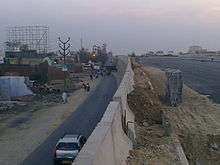National Highway 58 (India, old numbering)
National Highway 58 (NH 58) is a national highway in India. It links Ghaziabad in Uttar Pradesh near New Delhi with Badrinath and Mana Pass in Uttarakhand near Indo-Tibet border. This 538 km (334 mi) highway starts from Mana village near Indo-Tibet border north of Badrinath temple and passes through Badrinath, Joshimath, Chamoli, Vishnuprayag, Nandaprayag, Karnaprayag, Rudraprayag, Srinagar, Devprayag, Rishikesh, Haridwar, Roorkee, Muzaffarnagar, Khatauli, Meerut and Modinagar and ends at Ghaziabad near the border with Delhi.
| ||||
|---|---|---|---|---|
.png) Road map of India with NH 58 highlighted in thick blue colour | ||||
| Route information | ||||
| Length | 538 km (334 mi) | |||
| Major junctions | ||||
| South end | Ghaziabad, Uttar Pradesh | |||
| North end | Badrinath, Uttarakhand | |||
| Location | ||||
| States | Uttar Pradesh: 165 km (103 mi) Uttarakhand: 373 km (232 mi) | |||
| Primary destinations | New Delhi - Ghaziabad - Meerut - Muzaffarnagar - Haridwar - Rishikesh - Joshimath - Badrinath - Mana Pass | |||
| Highway system | ||||
| ||||
Of its total length, the NH 58 traverses 165 km (103 mi) in Uttar Pradesh and 373 km (232 mi) in Uttarakhand.[1]
The highway is constructed and maintained by National Highway Authority of India from Delhi to Rishikesh and Border Roads Organisation (BRO) of Indian Army from Rishikesh, where the plains end and the mountains start, to its northernmost end. The highway bypasses Meerut city that was a big bottleneck. Bypasses at Muzaffarnagar has been constructed but bypass at Roorkee is pending.[2]
Importance of NH58
Religious
It is an important route for Hindu pilgrims as it connects the national capital New Delhi with religious pilgrim centres, Haridwar and Rishikesh in the plains of Uttarakhand, and then with the hill cities and temples of Uttarakhand. The most important pilgrimage circuit in Uttarakhand is called Chhota Char Dham (Four Pilgrimage Centres) comprising Yamunotri (where Yamuna river originates), Gangotri (where Ganga river originates), Kedarnath temple and Badrinath temple. The pilgrims visit Haridwar and Rishikesh in the plains the entire year but more so during the winter. The pilgrim season in the hills starts with melting of the snow at the end of April or in the beginning of May and continues until the onset of monsoon rains in late June. Buses and vehicles packed with pilgrims and tourists throng the highway during the summer months.
The highway is packed with pilgrims and tourists during pilgrimage season or during important festivals.[3] When pilgrims bring holy water from Ganga river and carry it to their villages and homes walking on foot all the way during one fortnight, one lane of the highway is reserved for these pilgrims who walk on foot and vehicles have to use only one lane for about two weeks in a year.
Strategic and military
The highway connects with the border with Tibet. It is built and maintained by Border Roads Organisation (BRO) of Indian Army from Rishikesh, where the plains end and the mountains start, to its northernmost end. Earlier it was built only up to Chamoli and has over the years gradually been extended to Joshimath, Badrinath and finally to Mana Pass near the border with Tibet. The army along with civilians living in Garhwal are its major user. CharDham yatra in summer is all thru this route.
Development
As of December 2013, the Meerut to Muzaffarnagar stretch is 4-laned on toll basis including bypasses at Khatauli and Muzaffarnagar. The Muzaffarnagar to Haridwar stretch has been awarded for similar development with scheduled completion by February 2013, but has been delayed due to problems such as land acquisition, tree felling and inadequate mobilization by the Concessionaire.[4] Also, a flyover at Mohan Nagar, a 4710 m long viaduct at Modinagar and a 1710 m long viaduct at Murad Nagar are proposed.[5]
Gallery

 NH 58 is important trade route to hill-set Garhwal region of Uttarakhand.
NH 58 is important trade route to hill-set Garhwal region of Uttarakhand.
See also
- Delhi–Meerut Expressway
- List of National Highways in India (by Highway Number)
- National Highways Development Project
References
- "National Highways and their lengths". National Highways Authority of India. Archived from the original on 10 February 2010. Retrieved 12 February 2009.
- https://timesofindia.indiatimes.com/india/nhai-cancels-contract-for-dehradun-highway-serves-notice-for-haridwar-stretch/articleshow/65464585.cms
- "Major traffic jams on Somwati Amavasya: 20 lakh devotees take dip in Haridwar and Rishikesh". The Tribune. 23 June 2009.
- "Press Release - Development of Meerut-Muzaffarnagar-Haridwar Stretch". Press Information Bureau, Government of India. 17 December 2013. Retrieved 6 January 2014.
- "Press Release - Construction of Flyovers on National Highway-58". Press Information Bureau, Government of India. 9 December 2013. Retrieved 6 January 2014.
- https://www.amarujala.com/uttarakhand/roorkee/bypass-construction-started-by-removing-encroachment-roorkee-news-drn335384638
- https://timesofindia.indiatimes.com/city/dehradun/nh-58-project-to-be-completed-a-month-before-deadline-says-nhai-official/articleshow/73102906.cms



